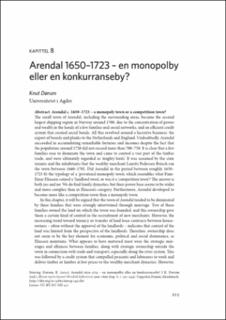| dc.contributor.author | Dørum, Knut | |
| dc.date.accessioned | 2023-12-06T12:28:52Z | |
| dc.date.available | 2023-12-06T12:28:52Z | |
| dc.date.created | 2023-01-10T14:52:47Z | |
| dc.date.issued | 2022 | |
| dc.identifier.citation | Sitering: Dørum, K. (2022). Arendal 1650–1723 – en monopolby eller en konkurranseby? I K. Dørum (red.), Hvem styrte byene? Nordisk byhistorie 1500–1800 (kap. 8, s. 215–244). Cappelen Damm Akademisk. | en_US |
| dc.identifier.isbn | 9788202716257 | |
| dc.identifier.uri | https://hdl.handle.net/11250/3106236 | |
| dc.description.abstract | The small town of Arendal, including the surrounding areas, became the second largest shipping region in Norway around 1700, due to the concentration of power and wealth in the hands of a few families and social networks, and an efficient credit system that created social bonds. All this revolved around a lucrative business: the export of boards and planks to the Netherlands and England. Undoubtedly, Arendal succeeded in accumulating remarkable fortunes and incomes despite the fact that the population around 1720 did not exceed more than 700–750. It is clear that a few families rose to dominate the town and came to control a vast part of the timber trade, and were ultimately regarded as ‘mighty lords’. It was assumed by the state tenants and the inhabitants that the wealthy merchant Lauritz Pedersen Brinch ran the town between 1660–1702. Did Arendal in the period between roughly 1650–1723 fit the typology of a ‘privatized monopoly town’, which resembles what Finn-Einar Eliassen coined a ‘landlord town’, or was it a ‘competition town’? The answer is both yes and no. We do find family dynasties, but their power base seems to be wider and more complex than in Eliassen’s category. Furthermore, Arendal developed to become more like a competition town than a monopoly town.
In this chapter, it will be argued that the town of Arendal tended to be dominated by three families that were strongly intertwined through marriage. Two of these families owned the land on which the town was founded, and this ownership gave them a certain kind of control in the recruitment of new merchants. However, the increasing trend toward tenancy or transfer of land lease contracts between houseowners – often without the approval of the landlords – indicates that control of the land was limited from the perspective of the landlords. Therefore, ownership does not seem to be the key element for economic, political and social dominance, as Eliassen maintains. What appears to have mattered most were the strategic marriages and alliances between families, along with strategic ownership outside the town in connection with trade and transport, especially along the river system. This was followed by a credit system that compelled peasants and labourers to work and deliver timber or lumber at low prices to the wealthy merchant dynasties. However, the family dynasties did not end up monopolizing trade completely. They did not have the power to do so, nor was it in their interest to establish a trade monopoly. The number of families grew between 1650–1723, and by 1720, the town had 15–20 wealthy families. At the same time, about 50 merchant families in the Arendal area were heavily involved in the timber business. | en_US |
| dc.language.iso | nob | en_US |
| dc.publisher | Cappelen Damm Akademisk | en_US |
| dc.relation.ispartof | Hvem styrte byene? Nordisk byhistorie 1500–1800 | |
| dc.relation.uri | https://press.nordicopenaccess.no/index.php/noasp/catalog/book/149 | |
| dc.rights | Attribution-NonCommercial-NoDerivatives 4.0 Internasjonal | * |
| dc.rights.uri | http://creativecommons.org/licenses/by-nc-nd/4.0/deed.no | * |
| dc.title | Arendal 1650-1723 - en monopolby eller en konkurranseby? | en_US |
| dc.title.alternative | Arendal 1650-1723 - en monopolby eller en konkurranseby? | en_US |
| dc.type | Chapter | en_US |
| dc.description.version | publishedVersion | en_US |
| dc.rights.holder | © 2022 The Author(s) | en_US |
| dc.subject.nsi | VDP::Humaniora: 000::Historie: 070 | en_US |
| dc.source.pagenumber | 215-244 | en_US |
| dc.identifier.doi | https://doi.org/10.23865/noasp.149.ch8 | |
| dc.identifier.cristin | 2104309 | |
| cristin.qualitycode | 1 | |

